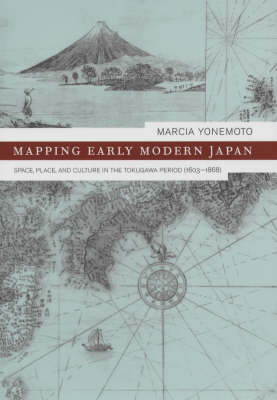
Mapping Early Modern Japan
Space, Place, and Culture in the Tokugawa Period, 1603-1868
Seiten
2003
University of California Press (Verlag)
978-0-520-23269-3 (ISBN)
University of California Press (Verlag)
978-0-520-23269-3 (ISBN)
This work considers several texts, cultural practices and intellectual processes to chart the emergence of a new geographical conciousness in early modern Japan. The study shows how spatial and geographical knowledge confined to elites in early Japan became more widespread in the Tokugawa period.
This elegant history considers a fascinating array of texts, cultural practices, and intellectual processes--including maps and mapmaking, poetry, travel writing, popular fiction, and encyclopedias--to chart the emergence of a new geographical consciousness in early modern Japan. Marcia Yonemoto's wide-ranging history of ideas traces changing conceptions and representations of space by looking at the roles played by writers, artists, commercial publishers, and the Shogunal government in helping to fashion a new awareness of space and place in this period. Her impressively researched study shows how spatial and geographical knowledge confined to elites in early Japan became more generalized, flexible, and widespread in the Tokugawa period. In the broadest sense, her book grasps the elusive processes through which people came to name, to know, and to interpret their worlds in narrative and visual forms.
This elegant history considers a fascinating array of texts, cultural practices, and intellectual processes--including maps and mapmaking, poetry, travel writing, popular fiction, and encyclopedias--to chart the emergence of a new geographical consciousness in early modern Japan. Marcia Yonemoto's wide-ranging history of ideas traces changing conceptions and representations of space by looking at the roles played by writers, artists, commercial publishers, and the Shogunal government in helping to fashion a new awareness of space and place in this period. Her impressively researched study shows how spatial and geographical knowledge confined to elites in early Japan became more generalized, flexible, and widespread in the Tokugawa period. In the broadest sense, her book grasps the elusive processes through which people came to name, to know, and to interpret their worlds in narrative and visual forms.
Marcia Yonemoto is Assistant Professor of History at the University of Colorado at Boulder.
| Erscheint lt. Verlag | 21.4.2003 |
|---|---|
| Reihe/Serie | Asia: Local Studies / Global Themes ; 7 |
| Zusatzinfo | 22 b-w illustrations |
| Verlagsort | Berkerley |
| Sprache | englisch |
| Maße | 152 x 229 mm |
| Gewicht | 499 g |
| Themenwelt | Reiseführer ► Asien ► Japan |
| Geschichte ► Allgemeine Geschichte ► Neuzeit (bis 1918) | |
| Geisteswissenschaften ► Geschichte ► Regional- / Ländergeschichte | |
| Geisteswissenschaften ► Geschichte ► Teilgebiete der Geschichte | |
| ISBN-10 | 0-520-23269-0 / 0520232690 |
| ISBN-13 | 978-0-520-23269-3 / 9780520232693 |
| Zustand | Neuware |
| Haben Sie eine Frage zum Produkt? |
Mehr entdecken
aus dem Bereich
aus dem Bereich
Buch | Hardcover (2012)
Westermann Schulbuchverlag
34,95 €
Schulbuch Klassen 7/8 (G9)
Buch | Hardcover (2015)
Klett (Verlag)
30,50 €
Buch | Softcover (2004)
Cornelsen Verlag
25,25 €


